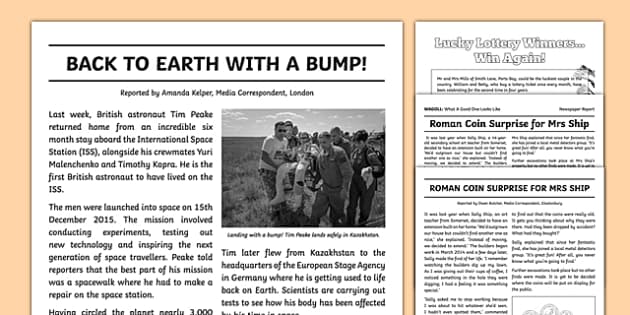The smart Trick of News Articles That Nobody is Discussing
The smart Trick of News Articles That Nobody is Discussing
Blog Article
3 Easy Facts About News Articles Explained
Table of ContentsNews Articles - The FactsThe Ultimate Guide To News ArticlesThe Main Principles Of News Articles Little Known Facts About News Articles.Getting My News Articles To Work
Great knowledge of various subjects provides pupils a competitive side over their peers. Despite the fact that digital and social media are conveniently obtainable, we must not forget just how crucial it is to read the papers. Parents need to try and instill the practice of reading a paper as a daily routine to continue the tradition of the revered print medium.Information tales also include at the very least one of the complying with vital qualities about the intended audience: distance, importance, timeliness, human passion, strangeness, or consequence. The associated term journalese is occasionally used, typically pejoratively, to describe news-style writing. An additional is headlinese. Papers generally follow an expository writing style.
Within these limits, newspaper article additionally intend to be comprehensive. Other variables are entailed, some stylistic and some acquired from the media kind. Among the larger and much more reputable newspapers, fairness and equilibrium is a significant consider providing info. Commentary is usually confined to a different area, though each paper may have a different overall angle.
Newspapers with a global audience, for instance, tend to utilize an extra formal design of writing. News Articles.; usual style guides consist of the and the US Information Style Book.
Everything about News Articles
As a regulation, reporters will certainly not make use of a lengthy word when a brief one will do. News writers try to prevent utilizing the same word much more than once in a paragraph (in some cases called an "resemble" or "word mirror").
However, headlines in some cases omit the subject (e.g., "Leaps From Watercraft, Catches in Wheel") or verb (e.g., "Feline lady lucky"). A subhead (likewise subhed, sub-headline, subheading, subtitle, deck or dek) can be either a subordinate title under the major heading, or the heading of a subsection of the post. It is a heading that precedes the main message, or a group of paragraphs of the main message.

of a post subject, informant, or interviewee), it is described as a pulled quote or pull quote. Extra signboards of any one of these types may appear later in the short article (particularly on subsequent pages) to attract further reading. Journalistic websites in some cases use animation techniques to swap one signboard for another (e.g.
Facts About News Articles Revealed
Such signboards are additionally utilized as tips to the post in other sections of the magazine or site, or as advertisements click to read for the piece in other publication or sites. Press launch of the Swiss government. Common framework with title, lead paragraph (summary in vibrant), other paragraphs (information) and get in touch with information.

Instance of a hard-lead paragraph NASA is suggesting another area project. The spending plan requests about $10 billion for the job.
The NASA news came as the company asked for $10 billion of appropriations for the job. An "off-lead" is the 2nd most crucial front page information of the day. The off-lead shows up either in the leading left corner, or straight listed below the lead on the. To "bury the lead" is to begin the post with history info or information of additional importance to the viewers, forcing them to learn more deeply into an article than they must have to in order to find the essential factors.
The 2-Minute Rule for News Articles
Typical use is that a person or more sentences each create their very own paragraph. Reporters generally define the company or framework of an information tale as an upside down pyramid. The essential and most interesting elements of a story are put at the beginning, with sustaining details following in order of diminishing importance.
It allows individuals to discover a topic to only the depth that their curiosity takes them, and without the charge of information or subtleties that they might consider irrelevant, but still making that details readily available to a lot more interested visitors. The inverted pyramid framework likewise allows short articles to be cut to any kind of arbitrary length throughout design, to fit in the room offered.
Some writers begin their stories with the "1-2-3 lead", yet there are several kinds of lead offered. A kicker can refer to several things: The last tale in the information broadcast; a "happy" tale to end try this out the program.
Longer posts, such as publication cover posts and the items that lead the inside areas of a newspaper, are called. Function tales differ from straight news in several means. Foremost pop over to this web-site is the absence of a straight-news lead, a lot of the moment. Rather than offering the essence of a tale in advance, function authors might attempt to draw readers in.
The News Articles Ideas
The reporter often details interactions with interview subjects, making the piece a lot more individual. A function's initial paragraphs usually relate an interesting moment or event, as in an "anecdotal lead". From the particulars of an individual or episode, its sight promptly widens to generalizations concerning the story's topic. The area that signifies what an attribute is around is called the or billboard.

The Editor's Tool kit: A Recommendation Overview for Beginners and Professionals (2001) Allan M. Siegal and William G. Connolly. The New York City Times Manual of Design and Use: The Official Style Overview Made Use Of by the Writers and Editors of the World's The majority of Authoritative Paper (2002) M. L. Stein, Susan Paterno, and R.
Report this page